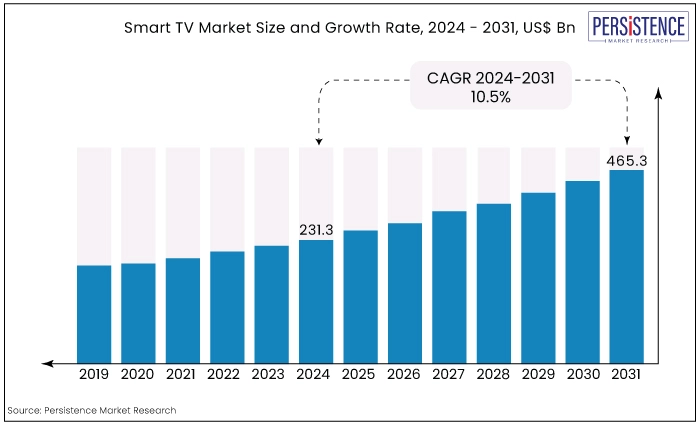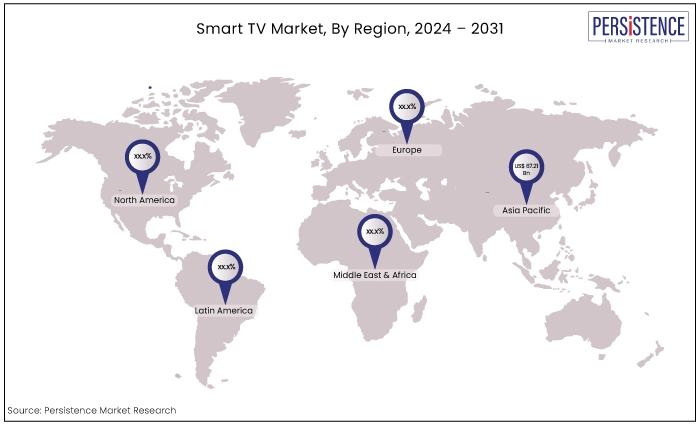Industry: Semiconductor Electronics
Format: PPT*, PDF, EXCEL
Delivery Timelines: Contact Sales
Report Type: Ongoing
Report ID: PMRREP34663
The market was estimated at US$231.3 Bn in 2024 and is expected to be valued at US$465.3 Bn by 2031. It is expected to reach a growing, robust CAGR of 10.5% from 2024 to 2031.
Key Highlights of the Market
|
Attributes |
Key Insights |
|
Smart TV Market Size (2024E) |
US$231.3 Bn |
|
Projected Market Value (2031F) |
US$465.3 Bn |
|
Global Market Growth Rate (CAGR 2024 to 2031) |
10.5% |
|
Historical Market Growth Rate (CAGR 2019 to 2023) |
9.4% |
The smart TV market has experienced significant growth in recent years, driven by technological advancements and changing consumer preferences. Smart televisions are television sets that are equipped with internet connectivity and offer a range of interactive features, such as online streaming, recording, and storage capabilities. They have revolutionized the way people consume media and entertainment content.
The smart TV industry was valued at US$231.3 billion in 2024 and is projected to reach US$465.3 billion by 2031, registering a solid CAGR of 10.5% from 2024 to 2031.
One of the smart TV market trends that is fueling the market is the introduction of affordable smart HD TVs by major Chinese providers. These TVs have unlocked a new era for middle-class TV users.
People are interested in watching OTT platforms like Amazon Prime, Netflix, and Disney Plus, boosting the demand for smart televisions. The high demand for smart televisions is due to advanced features like voice commands, screen mirroring and sharing, and video calling.
The COVID-19 pandemic has pushed people to turn to indoor entertainment, leading to a rise in internet video streaming and the demand for smart TVs. Additionally, manufacturers are introducing their own operating systems for smart TVs, such as Samsung's Tizen and LG's Magic Remote, which is expected to drive market expansion.
Further, the trend of video-on-demand (VoD) is expected to drive market growth as smart televisions support popular video platforms and interactive features like voice input and remote cursor.

The smart TV sector has expanded over the years. The smart TV market size reached approximately US$147.6 Bn in 2019. Various factors, such as technological advancements, increasing demand for connected entertainment experiences, and rising disposable incomes of consumers, drove this growth.
The market is projected to reach US$231.3 Bn in 2024 and US$465.3 Bn by 2031, growing at a compound annual growth rate (CAGR) of 10.5% from 2024 to 2031. This market expansion is attributed to the trend of video-on-demand (VoD).
As televisions support various popular video platforms that offer on-demand content, people are interested in investing in these TVs to enjoy diverse features and technologies.
The increasing desire for individualized entertainment experiences and the convergence of devices to eliminate the need for separate devices are also expected to propel the market.
Technological advancements and exploration of emerging markets will play a crucial role in sustaining the growth of the smart TV industry.
Technological Advancements
Continuous advancements in display technologies, such as OLED, QLED, and HDR, enhance the visual experience and attract consumers looking for high-quality content. Integration of voice control, artificial intelligence, and smart home integration features further enhance the appeal of smart televisions, driving market growth.
Increasing Demand for Connected Entertainment
With the rise of streaming services, online content consumption has surged. Smart televisions provide seamless access to popular streaming platforms, allowing users to enjoy a wide range of content on a larger screen. This growing demand for connected entertainment experiences is fueling the adoption of smart televisions.
Rising Disposable Incomes
As disposable incomes rise globally, consumers have more purchasing power to invest in technologically advanced products like smart TVs. With increased affordability and availability of smart televisions across different price segments, more consumers are opting for these feature-rich devices, contributing to the growth of the market.
Price Sensitivity
While the prices of smart televisions have become more affordable over time, price sensitivity remains a significant factor hindering market growth. Consumers, especially in price-sensitive markets, may opt for traditional TVs or lower-priced alternatives due to budget constraints.
The small price difference between larger-sized smart TVs and regular-sized TVs may also lead some buyers to choose larger displays, impacting the demand for smaller-sized smart televisions.
Competition from Alternative Devices
The smart TV market faces competition from alternative devices that offer similar functionalities. Streaming devices, such as media players and set-top boxes, provide internet connectivity and access to streaming services on regular TVs.
Additionally, the increasing popularity of smartphones and tablets as media consumption devices poses a challenge to the market expansion. Consumers may prefer the convenience and portability of these devices over investing in a separate smart television.
Rising Popularity of OTT Services
The increased popularity of content on over-the-top (OTT) services, such as streaming platforms, presents a significant opportunity for the smart TV industry.
Smart televisions provide seamless access to these services, allowing users to stream their favorite movies, TV shows, and other content directly on their television screens. As the demand for OTT services continues to grow, smart televisions are well-positioned to cater to this trend and capture a larger market share.
Rising High-Speed Internet Connection
The market has expanded as high-speed connectivity and internet penetration have grown. With the internet's expansion, various products in different categories have gained internet access capabilities, bringing unique value propositions. This has introduced the concept of a digital home, transforming consumer goods and home entertainment products.
The increasing popularity of audio and video entertainment has sparked discussions around the significance of smart televisions. As a result, internet connectivity has become crucial for the functioning of smart televisions. Therefore, the market's growth is heavily expected to be influenced by the expansion of high-speed internet access.
Full HD TV Dominates the Resolution Segment
The smart TV sector can be segmented based on resolution, which includes 4K UHD TV, HDTV, Full HD TV, and 8K TV. In 2021, the full HD TV segment dominated the market, contributing to approximately 45% of the smart TV market revenue.
Full HD TV offers a resolution of 1920 x 1080 pixels, which has been the industry standard for many years. This resolution is widely adopted as a significant amount of content is compatible with it.
Streaming content and watching live sports at this resolution does not require high internet bandwidth while still providing an immersive and high-quality viewing experience.
Android TV Sales Heighten on the Back of Diverse Features
Based on operating systems, the Android TV segment emerged as the dominant player in the market in 2021 and is expected to experience rapid growth during the forecast period of 2024-2031.
The segment's success can be attributed to its access to the Play Store, allowing users to download a wide range of applications. Additionally, Android TV offers features such as voice search and content aggregation from multiple media apps and services.
The operating system also enables seamless integration with Google technologies like Knowledge Graph, Cast, and Assistant. As a result, the increasing applications for smart televisions positively impact the overall market growth.
Smart TVs of 46 to 55 inches Screen Size Most Favored
Based on screen size, in 2021, the 46 to 55-inch segment emerged as the dominant player in the market and is projected to be the fastest-growing segment during the forecast period of 2024-2031.
The growth can be attributed to the increasing trend of consumers purchasing larger TVs to replicate a theater-like viewing experience. The demand for this segment is driven by the value consumers perceive in terms of screen size and price.
Flat-Screen Gains Traction on Account of Affordability
Based on screen shape, the flat-screen segment dominated the market in 2021 due to its status as the industry standard and its ease of manufacturing.
Consumers prefer flat-screen smart televisions because they are easier to mount on walls and offer easier installation and maintenance. Flat screens are also more affordable compared to curved screens, contributing to their high demand.
Asia Pacific Represents a Substantial Market Share
The Asia Pacific region accounted for a significant share of the smart TV market, with revenues reaching US$67.21 Bn in 2021. This region is expected to exhibit significant growth during the study period, driven by the growing popularity of smart televisions in rapidly developing countries like India.
China holds a significant share in the Asia Pacific market, with the emergence of new players contributing to increased competition among major players. China's smart TV sector holds the largest market share, while the Indian market is the fastest-growing in the region.
Europe Holds Promise to a Host of Opportunities
The European market holds the second-largest market share. The presence of low-cost manufacturers and increasing internet penetration are driving innovation in smart televisions, offering the latest features at competitive prices to meet diverse customer needs. Germany holds the largest market share in the European market, while the UK market is the fastest-growing.
North America's OTT Platform Advances
The North American smart TV market is expected to grow at the fastest CAGR from 2024 to 2031. The region's growth is fueled by developments in the over-the-top (OTT) segment, leading to increased adoption of smart televisions. The availability of high-speed internet connections and the changing consumer focus on streaming online content further contribute to the demand for smart televisions. The US holds the largest market share in the North American market, while Canada is the fastest-growing market in the region.

The smart TV industry is dedicated to expanding by acquiring established market players and innovations. This trend is accompanied by the emergence of startups introducing their unique smart television offerings, resulting in a highly diverse and competitive market landscape.
To stay ahead of evolving market trends, companies are making substantial investments to expand production capabilities and enhance their technological features. Their goal is to develop innovative features and integrate technologies into smart televisions that can be effectively introduced and embraced by the market.
Recent Industry Developments
June 2024, Samsung, a leading TV manufacturer, is focusing on incorporating artificial intelligence into its latest Neo QLED and OLED TVs. These smart televisions offer a transformative viewing experience with double the computational power, delivering precise content display in both 4K and 8K resolutions. The innovative NQ8 AI Gen3 processor enhances image quality, while the AI Motion Enhancement PRO feature ensures sharp and clear visuals even during fast-moving scenes. Samsung's AI-driven sound technology, including AI Active Voice Amplifier Pro and Object Tracking Sound, creates an immersive audio environment, enhancing overall viewing engagement.
February 2024, VIZIO has been named an Emmy® recipient for the 75th annual Technology & Engineering Emmy® Awards by the National Academy of Television Arts & Sciences (NATAS). The NATAS Committee recognized VIZIO for its Large Scale Deployment of its Smart TV Operating System, which powers better viewing experiences for millions of consumers. VIZIO, a pioneer in the Smart TV marketplace, has been recognized for its consumer-focused vision and world-class engineering team's execution to deliver exceptional entertainment experiences for users nationwide.
|
Attributes |
Details |
|
Forecast Period |
2024 to 2031 |
|
Historical Data Available for |
2019 to 2023 |
|
Market Analysis |
US$ Billion for Value |
|
Key Country Covered |
|
|
Key Market Segments Covered |
|
|
Key Companies Profiled |
|
|
Report Coverage |
|
|
Customization & Pricing |
Available upon request |
By Operating System
By Resolution
By Screen Size
By Screen Shape
By Geographical Regions
To know more about delivery timeline for this report Contact Sales

The market is predicted to rise from US$231.3 Bn in 2024 to US$465.3 Bn by 2031.
Growing interest in watching content available on over-the-top platforms and innovative features in smart televisions. are propelling market growth.
Haier Inc., Hisense International, Intex Technologies, and Koninklijke Philips N.V are some examples of key industry players.
Competition from alternative devices and price sensitivity in the market are restraining market expansion.
Influence of celebrities and social media and increasing interest in organic products are the major factors creating opportunities in the market.